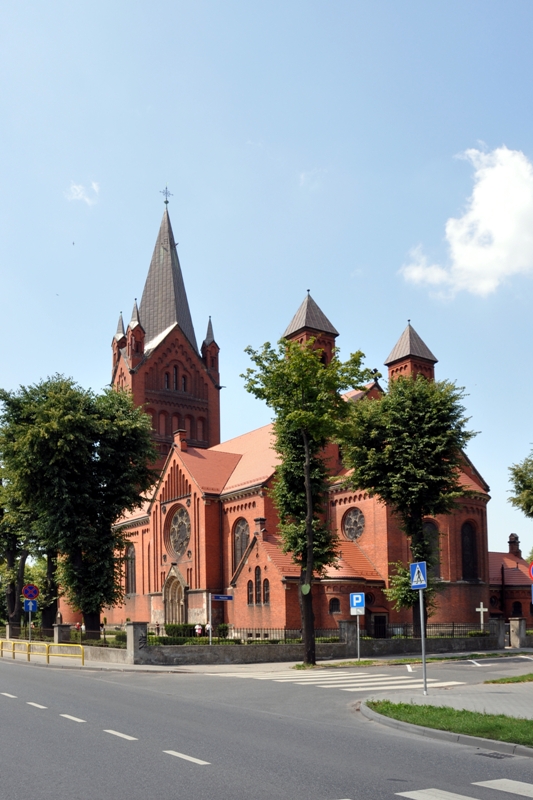
INOWROCŁAW
The capital-town of West Kujawy (Kuyavia), Inowrocław is a county town with a rich history behind it. A health resort, it is an important station on the Piast Route.
History
Inowrocław was first mentioned in 1185. In mid-13th century, Inowrocław was granted its Magdeburg municipal rights. Situated not far from the Teutonic-Order state frontier, it was frequently exposed to raids of its army. 1321 saw announcement of a papal court verdict in a dispute between King Ladislaus I the Elbow-high (Władysław Łokietek) and the Teutonic Order. Since mid-14th century, Inowrocław has been the Province’s capital and the starosty (district authorities’) seat. It was a royal property. To protect it against pillages, mainly from the Teutonic knights, ramparts and moats were built there in 15th century. There were three gates within these walls (called the Toruń/Thorn, Bydgoszcz and Poznań Gate, respectively) as well as sixteen donjons. Within the ramparts was a castle. In 1458, Inowrocław was obligated to send its twenty soldiers to the Marienburg expedition (i.e. as many as Gniezno did; Poznań sent sixty).
The Swedish wars and plagues obstructed the city’s development. In 1772, Inowrocław became part of the Prussian Partition area. A salt mine and saltworks were established in 1873. By the end of the nineteenth century, Inowrocław had risen to become a railway interchange and industrial hub of importance. A health resort was set up there in 1875. On 5th January 1919, following heavy warfare, the town was overcome by Wielkopolska insurgents. During the Nazi occupation, there was a labour camp operating in Błonie area, whereas prisoners-of-war were gaoled at Mątwy; Łojewo, in turn, became the site of a labour camp for the Jews. Inowrocław was liberated on 22nd January 1945.
Worth Seeing
South-west of the Market Square is St. Nicholas’s church. Redeveloped several times, it is now a late-gothic three-nave basilica.
At Klasztorny Square is a neo-Romanesque Holy Cross church, a former Evangelical temple built in 1863.
Somewhat further up, at 19 Kościuszki St. is one of Inowrocław’s oldest tenement houses whose framework is gothic; it was the seat of the municipal scales from 16th till 19th century.
The ‘Jan Kasprowicz’ Museum (2 Klasztorny Sq.) has collections on the history of the town along with biographical/souvenir items devoted to outstanding personages of West Kujawy, as well as keepsakes of a today-non-existent salt mine. At B-pa Laubitza St. you will see a church of the Name of Our Lady.
<!--{1The Annunciation of Our Lady church is one of the country’s most splendid neo-Romanesque temples.
The western section of Solankowa Street and the health-resort-quarter streets adjacent thereto are the venues of sanatoria, pension and residential house buildings dating to the late 19th/early 20th century.
At 16 Kopernika Ave. is St. Barbara’s and St. Maurice’s church, built in 1927–1929 after the design by Marian Andrzejewski – one of Poland’s first reinforced-concrete-structure churches.
Going westwards, Solankowa Street will lead you to the Brine Park. The establishment of Inowrocław’s health resort was associated with occurrence underneath the town layer of a salt dome and the start-up of a salt mine. Brine springs were first found there in 1835, at a 25-m depth. The salt mine and saltworks were set up in 1873. The city’s location upon a large underground salt dome causes appearance of numerous sources of salty waters in its area. The first baths institution emerged in Inowrocław in 1875; the period between the two World Wars witnessed a considerable development of the health resort and spa. Today, it ranks among the largest such facilities in Polish lowlands, with its services being used by some 20,000 people annually. The resort’s base of operations is iodine-bromic brines with a rich content of potassium and magnesium salts and a considerable concentration (ca. 3.2% – one of Europe’s strongest), along with bitter brines – similar to those appearing in Karlovy-Vary, with salt concentration of 0.4–1.6%. The resort and spa are equipped with numerous brine, carbonic-acid, oxygenic, and peat bathing appliances. A major facility is a physiotherapy institution with its hydrotherapeutics ward, inhalation station, physical therapy ward and a mineral waters pump room.
For more information, go to:
www.inowroclaw.pl/en






